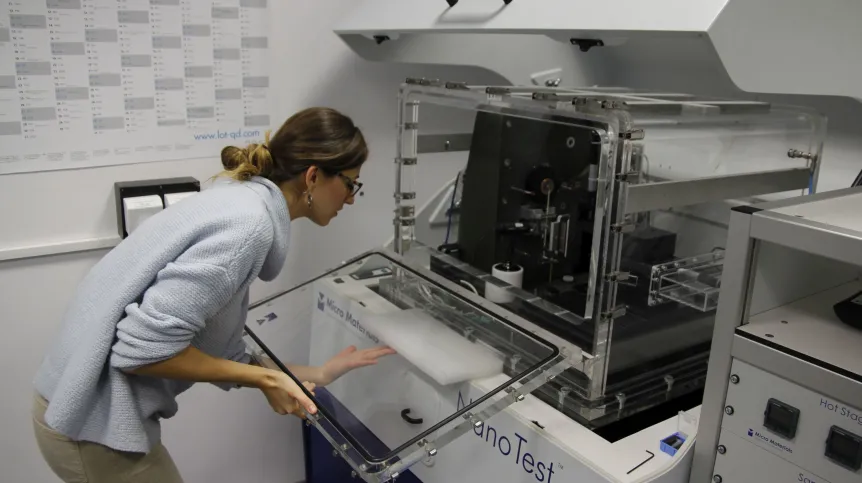
The conditions inside high-temperature reactors (HTRs), are so extreme that it is difficult to find a material that can be used there. Polish research suggests that such a material may be among nickel and iron alloys, the National Centre for Nuclear Research reports.
Intense and prolonged neutron bombardment, high temperature and high pressure create an extremely hostile environment for most materials. Therefore, in the work on the construction of the latest Gen IV nuclear reactors, the focus is on the search for materials capable of maintaining high mechanical parameters in such adverse conditions. A promising candidate for such a material has recently been identified by a team of scientists from the National Centre for Nuclear Research (NCBJ) in Świerk, led by Professor Łukasz Kurpaska, the centre's spokesperson Dr. Marek Pawłowski reports in a release sent to PAP.
The researchers said: “High Temperature Reactors (HTR) are considered an important element of nuclear power. On the one hand, they are simply safe, because their design, operating parameters and fuel selection guarantee that any uncontrolled increase in temperature, instead of causing a chain reaction, will lead to its self-extinguishing.”
On the other hand, according to the NCBJ researchers, these reactors can meet the needs of modern industry, as they are able to supply steam at a temperature of 500 degrees Celsius or higher. This, in turn, makes it possible to use this steam as a source of technological heat in the chemical industry and even for the production of hydrogen.
The problem, however, is finding materials capable of meeting the requirements imposed by the specificity of the operation of HTR reactors.
“In recent years, a lot of attention has been paid to high-entropy alloys, created from at least five components of similar concentration and often similar atomic mass,” said Edyta Wyszkowska (NCBJ), the first author of the paper on radiation damage in nickel-iron alloys, recently published in the prestigious scientific journal Nanoscale(https://pubs.rsc.org/en/content/articlelanding/2023/NR/D2NR06178C).
She added: “Such materials have unique properties, including high yield strength, hardness at high temperature and very good resistance to radiation. By modifying their chemical composition, desired properties can be easily improved, for example to increase strength or ductility.”
Physicists from the National Centre for Nuclear Research are primarily interested in understanding the fundamental phenomena occurring inside materials exposed to radiation, and in determining the initial chemical composition around which further research can be conducted. For this reason, they focused on alloys of only two metals: nickel with iron.
The researchers said: “Both nickel and iron are common components of high-entropy alloys, which is why understanding the mechanisms responsible for the unique properties of the nickel-iron system would provide a solid foundation for further search for alloys with even better parameters.”
The team used nickel-iron single crystals produced at the National Centre for Nuclear Research. Four alloys with increasing iron content were used in the study.
To produce radiation damage identical to that resulting from the impact of the neutron stream, properly prepared samples of materials were placed in an ion implanter and subjected to ion stream.
Wyszkowska said: “Modified materials bombarded with ions instead of neutrons are non-radioactive and can be safely analysed in a laboratory. Importantly, this technique enables causing material defects quickly and precisely. In just a few or a dozen hours, radiation damage can be created in the outer layer of the material to a depth of a micrometer, which corresponds to the damage formed over several dozen years of reactor operation.”
An interesting picture of changes in nickel-iron alloys under the influence of radiation emerges from the analyses and simulations carried out in Świerk.
Research has shown that the alloy with the addition of 38 percent iron has the highest hardness, but the highest resistance to the formation of radiation defects is observed for the alloy containing the largest amount of iron, 62 percent. Moreover, defects in the latter alloy were uniformly distributed within the ion-modified layer, while in the other alloys they clustered near a certain depth. The research team said: “This is an important feature because clustering of defects is a dangerous phenomenon, potentially leading to delamination of the material.”
In light of the analyses carried out so far, the nickel alloy with 62 percent iron content seems to be a promising candidate for the construction material for Gen IV nuclear reactors and may be the basis for further research. Before it is used by engineers, further studies of its properties, especially at high temperatures, will have to be carried out, as well as many years of testing in a real reactor operating environment.
“The knowledge acquired by scientists from the National Centre for Nuclear Research will be used today, as it will allow to optimise further search for multi-component alloys with potentially even better mechanical parameters and high radiation resistance,” the researchers said.
Work on NixFe1-x alloys is carried out as part of the NOMATEN Centre of Excellence project, financed with grants from the Foundation for Polish Science, the European Commission and the Polish National Science Centre. (PAP)
Author: Ludwika Tomala
lt/ bar/ kap/
tr. RL













